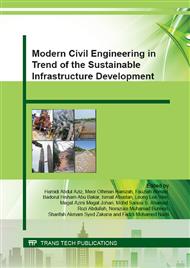p.525
p.531
p.537
p.543
p.549
p.557
p.563
p.569
p.575
Optimization of HCO3- Production Reflect to CaСo3 Precipitation for Self-Healing by Bacillus sphaericus
Abstract:
Bacteria are able to perform metabolic activities which promote the precipitation of calcium carbonate in the form of calcite. Bacillus Sphaericus was used in this study, which is an ureolytic bacteria that can precipitate calcium carbonate in its environment by the decomposition of urea into ammonium and carbonate. The bacterial degradation of urea basically increases the pH and promotes the microbial deposition of carbonate as calcium carbonate. In this research, the capability of bacteria to influence the formation of HCO3- by the production of urease enzyme was investigated. Results of growth rate and characteristics of bacteria showed that 20g/L of urea concentration was able to provide a good environment for bacteria with sufficient amount of nutrient to survive. The formation of HCO3- was parallel with NH3 production where the formation of HCO3- increased slowly as the ammonia production decreased. Urea degradation with suitable concentration of urea by 20g/L may form high HCO3- compared to 25g/L urea concentration. The results from the experimental works indicated that the optimal urea concentration was 20g/L.
Info:
Periodical:
Pages:
549-554
Citation:
Online since:
October 2015
Price:
Сopyright:
© 2015 Trans Tech Publications Ltd. All Rights Reserved
Share:
Citation:


